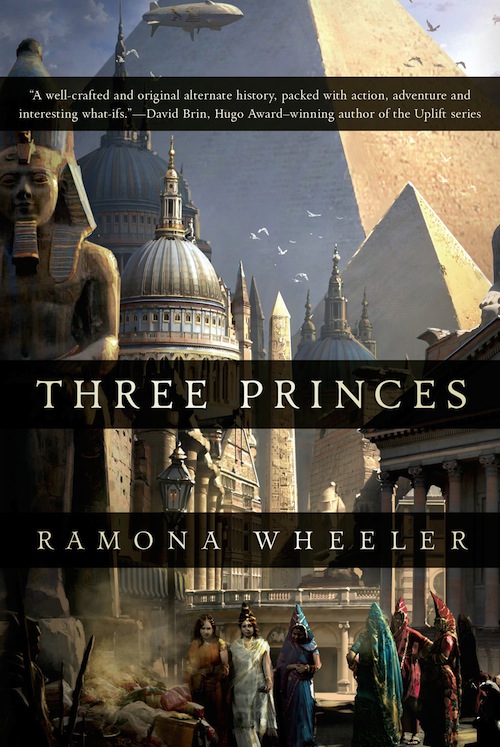Books come in all shapes and sizes. Someone should kick me for using that line. It’s about as cliché as it gets. But I mean it more abstractly than it’s often used. Stories have shapes, right? Kurt Vonnegut thought so. He plotted stories on a dual axis—the vertical G-I axis, for good fortune-ill fortune, bisected by the B-E axis, for beginning and end. While not every story has a bell shaped curve, most successful ones do, and most end higher on the G-I axis than they begin.
All of that goes to say that Ramona Wheeler’s Three Princes is a book of an odd shape. Lord Scott Oken, a prince of Albion, and Professor-Prince Mikel Mabruke are spies for the Egyptian Empire. In the year 1877 that empire spans Europe, Africa, and much of Asia. The Americas remain in the hands of the Incas, an empire to rival the Egyptians and ahead in the technological race. When rumors reach Egypt that the Incans are building rockets, Oken and Mabruke are sent to investigate.
Notice that’s only two princes where the title promises three. The final head of the triumvirate is an Incan royal revealed just before the halfway mark of the novel. Although an important part of the book, the Incan Prince is a side show compared to the covert Egyptian duo. Part James Bond, part Fafhrd and Gray Mouser, Oken and Mabruke are subject to a series of misfortunes across the globe, propelling them toward something like a sailboat without a rudder.
It’s that last part that engendered the opening to this review. Because Oken and Mabruke spend the entire novel in a reactive position and approach things with such a professional, if not stoic, demeanor, there’s very little variance in the G-I axis. The shape of Three Princes is a sine curve that never goes very far above or below the B-E axis. In part, that’s a function of the kinds of characters Wheeler chooses to write. They are not regular people, but exceptional ones who handle stress well and come out on top. The latter also makes them rather uninteresting because, well, they’re too good at stuff and the bad guys aren’t good enough.
All that said, I don’t really think Three Princes is a novel particularly concerned about the shape of its story or the emotional investment of its characters. Orson Scott Card breaks all stories into four components, which he calls the M.I.C.E. quotient—Milieu, Ideas, Character, and Event. All stories contain some element of all four, but one dominates, indicating the component the author is most fascinated by. Wheeler’s Three Princes is inherently a novel of milieu. It’s a novel obsessed with place, with what the world would look like if Egypt and Incan hegemony ran unchecked into the 19th century. From that perspective it’s hugely successful, filled as it is with lush descriptions of a more modern Memphis and the workings of Quetzal airships:
The captain was similar to other crewmen of the Quetzal, in that he was of slight build, like a jockey primed for riding champion racers. His oversized lungs gave his deep-barreled, hardy look a slight sense of disproportion. He was different, larger than life despite the great size and rank of the noblemen before him. His skin was polished mahogany, and tattooed on every visible bit with bloodred swirls and flame-colored curls flowing around upside-down faces and eyes. His kneecaps and elbows were condor heads, and a serpent in vivid green inks coiled around his neck and up his cheek, with the serpent’s head swallowing the Third Eye on his forehead. The Third Eye was done with such living detail that Oken expected to see it blink. Over these the captain wore only a short kilt of carved jade tiles that made a gentle clicking sound as he moved. He was barefoot and walked with the focused grace of a bird in flight. He bowed before the prince, and Oken fancied for an instant that he heard the sound of folding wings.
Wheeler treats us not just to detailed descriptions of ancillary characters, but to motorized vehicles across the North African desert, redolent coffee among nomadic tents, and blood thirsty sports in Incan arenas. The word treat is a perfect descriptor to describe the sensation of reading Three Princes. It is a series of treats, one after another, for the reader, an idealized and fantasy-like view from the top down of an Egyptian Empire that never was.
From the passage quoted above it should be clear the kind of novel Wheeler has written. For the reader who craves getting lost in a world, to picture themselves within it and all the cornucopia of delights (and dangers) that might entail, Three Princes is the kind of book to search out. Those more inclined toward character and plot, who yearn for growth and twists with peaks and valleys, perhaps not. It is not a novel of dynamic dialogue and narrative drive, but of ambiance and indulgence. Ramona Wheeler has written a novel of a certain type in search of a certain reader. It’s not me, but it could be you.
Three Princes is available February 4th from Tor Books.
Read an excerpt of the novel here on Tor.com
Justin Landon runs Staffer’s Book Review where his posts are less on-color. Find him on Twitter for meanderings on science fiction and fantasy, and to argue with him about whatever you just read.










